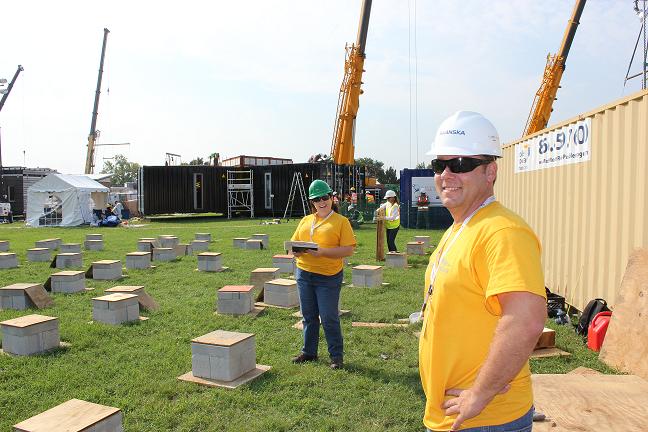Progress, Delays, and Generosity Characterize Second Full Day of Team Assembly
Thursday, September 15, 2011Carol Anna
Construction of the solar village on the National Mall’s West Potomac Park continued today, as student teams worked throughout the day and night to assemble their competition houses for the U.S. Department of Energy Solar Decathlon 2011.
While always a top priority at the Solar Decathlon, safety is particularly important during this seven-day construction phase. At today’s daily team meeting, Lee Ann Underwood, Solar Decathlon safety officer, praised the following teams for their excellent safety practices:
- New Zealand (Victoria University of Wellington)
- Tidewater Virginia (Old Dominion University and Hampton University)
- Canada (University of Calgary)
- Parsons NS Stevens (Parsons The New School for Design and Stevens Institute of Technology)
- The University of Tennessee.
As of this meeting, 12 of the 19 team houses had passed their foundation inspections, with the University of Tennessee and Team China (Tongji University) leading in the number of building inspections passed.
Unfortunately, only part of Team Massachusetts’ house has arrived. The team members expect the rest of the house to arrive tomorrow.

A member of Team Massachusetts demonstrates good humor while standing in the empty lot where her team house will be assembled. (Credit: Carol Anna/U.S. Department of Energy Solar Decathlon)
The truck carrying the foundation footings for Florida International University finally arrived, and the team was busy today setting the foundations.
Michele Markovits, project engineer for Florida International, couldn’t say enough good things about neighboring teams, whose generosity included Parsons NS Stevens, who helped by buying gas for their generator; Tennessee, who helped charge a battery and accepted safety glasses in return; and Appalachian State, whose loan of surveying equipment helped the team set its foundation footings.

Michele Markovits, project engineer for Florida International University, and other team members work on the foundation footings for their house. (Credit: Carol Anna/U.S. Department of Energy Solar Decathlon)
“Our fellow teams have been so generous, They’ve shown truly great sportsmanship,” Michelle said. “It’s important to all of us that we make it to the finish line.”
Carol Anna is the communications manager of the U.S. Department of Energy Solar Decathlon.


